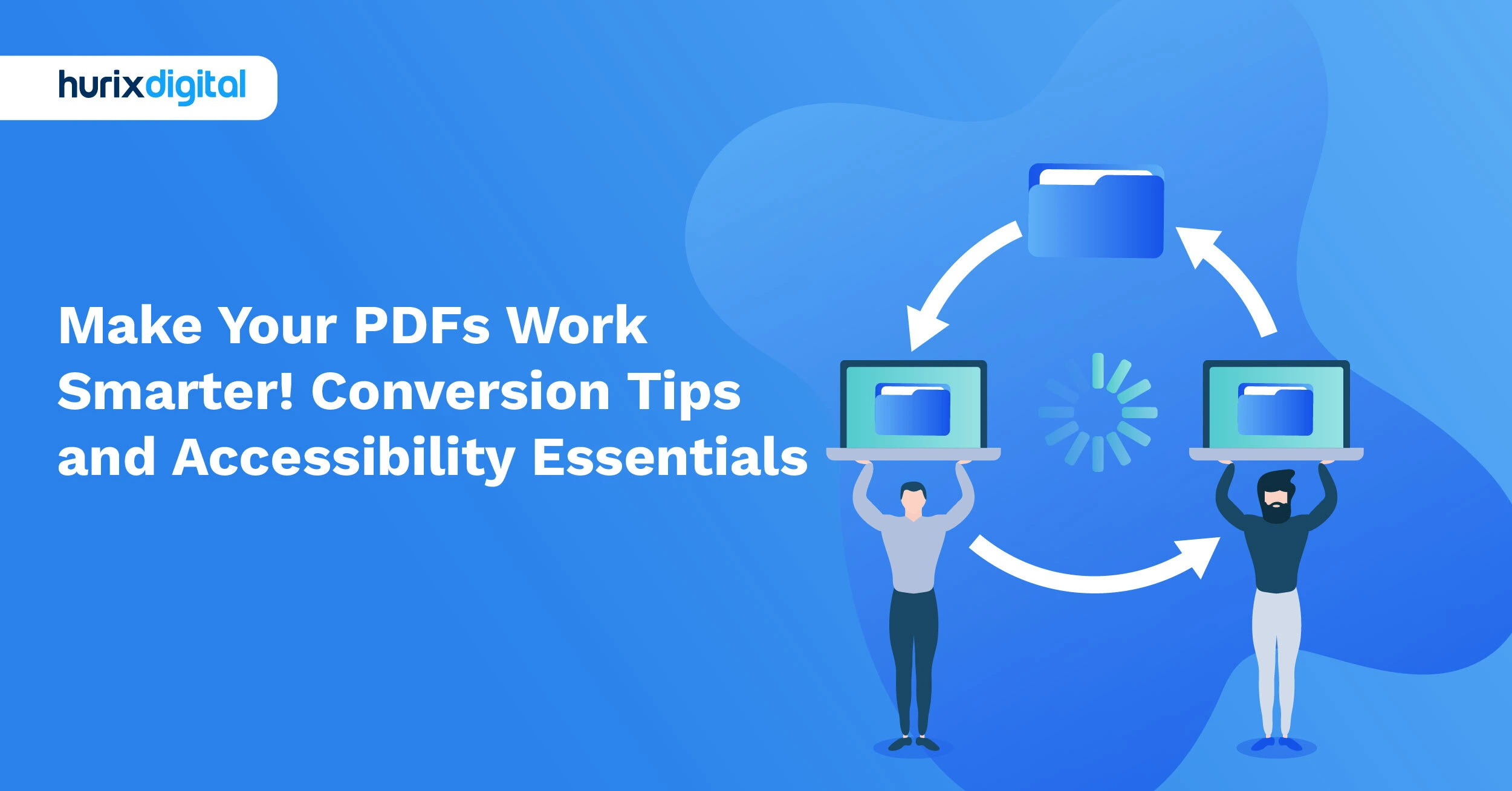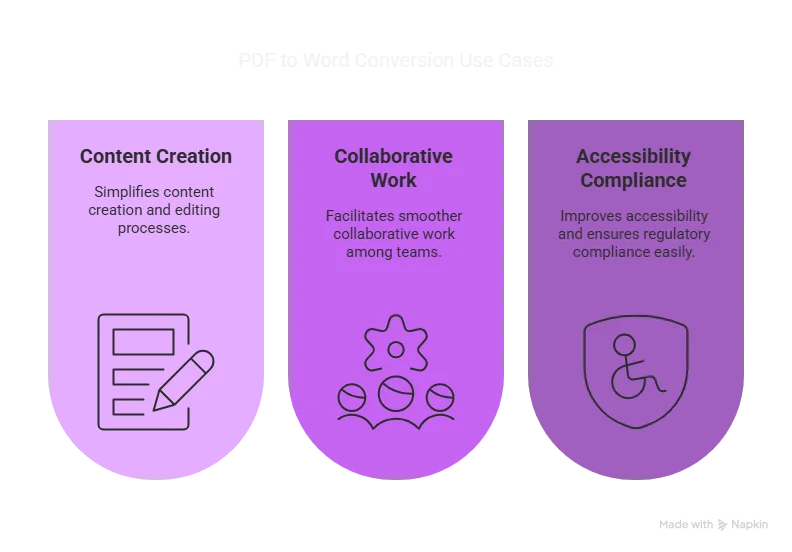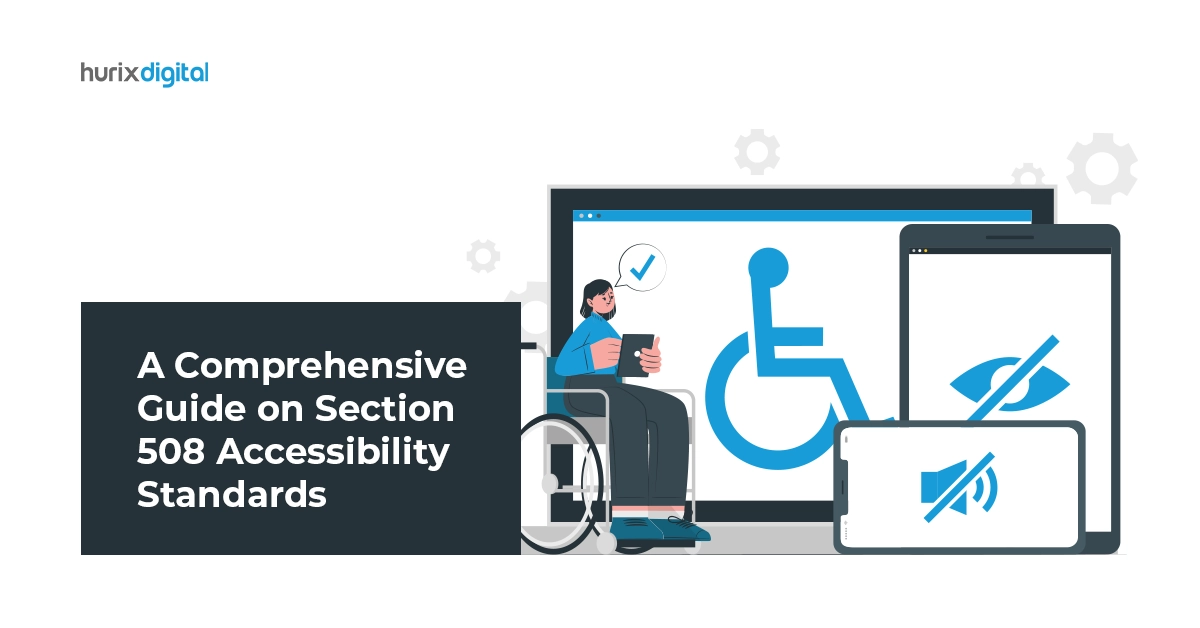
Make Your PDFs Work Smarter! Conversion Tips and Accessibility Essentials
Summarize with:
This blog explores how to boost the accessibility and functionality of your documents with PDF Conversion Services. You’ll find practical advice to create accessible PDFs that’s easier to use, more compliant, and efficient for both workplace and online environments.
Section 508 and the Americans with Disabilities Act (ADA) mandate that all public facilities be accessible to those with any type of disability to improve the quality of life for those with disabilities. Since PDF is the internet’s most widely used file format, it must be made available to comply with these laws.
The data obtained from the Bureau of Labor Statistics further highlight this fact. According to the data, 22.3% of individuals with disabilities held a job in 2022. Introducing accessible digital documents—Word, PDF, PPT, and so on—is one of the best ways to close the gaps for a significant portion of the workforce with disabilities.
However, as the process requires time and resources, many enterprises depend on expert PDF conversion services to finish the job quickly and affordably.
This blog explores the significant tips required for PDF complaint accessibility standards!
Table of Contents:
- The Power of PDF Conversion Services
- Understanding the Process: How to Convert PDF to Word
- Exploring the Features of PDF Editor Software
- Top 5 Ways to Optimize PDFs for Accessibility Standards
- Bonus Tips for PDF Inclusive Design
- Advantages of Investing in PDF Conversion Services
- Use Cases of PDF to Word Conversion Services
- Takeaway
The Power of PDF Conversion Services
Streamlining workflow becomes a breeze when you have the right tools at your disposal. One such tool is PDF editor software. It eases the process of converting PDF to Word doc, unlocking various benefits to enhance productivity.
Let’s delve into the multiple advantages and methods of using PDF Conversion Services to get the most out of your workdays.
- Efficiency and Speed: When you convert PDF to Word, you save time and effort. This conversion eliminates the need to retype content, thus enhancing efficiency and increasing speed.
- Modify with Ease: Editing a PDF directly can be daunting. By converting PDF to Word doc, you can effortlessly edit and format your document without jeopardizing the original’s layout or design.
- Accessibility: PDF to Word converter allows users to access and convert files on the go, making it easier to work with content across various platforms and devices.
- Data Security: Most PDF converter tools provide secure file conversion solutions, ensuring your data remains confidential.
Understanding the Process: How to Convert PDF to Word
In today’s digital world, PDF conversion services have become a necessity. Optimizing your workflow with reliable PDF editor software can transform how you manage documents, enhancing productivity and efficiency.
Here’s how you can convert PDF to Word:
- Choose the Preferred Software: The first step in converting PDF to Word involves selecting a reliable PDF editor software. Opt for a service provider that allows you to convert files online securely.
- Upload Your PDF File: After selecting the software, upload the PDF file you want to convert. It is typically achieved by clicking the “upload” button and selecting the file from your device.
- Start the Conversion Process: Most PDF editor software has a convert PDF to Word button. After uploading your file, click on this to begin the conversion.
- Save and Edit Your Word File: Once the conversion process is complete, save the Word document to your device. You can now edit the document as you please.
Utilizing reliable PDF tord conversion services will ensure that your document’s formatting is preserved during the conversion. It means less time spent tweaking and refining and more time dedicated to the task at hand.
Exploring the Features of PDF Editor Software
Maintaining a competitive edge requires having access to efficient tools like PDF editor software or services that convert PDF to Word. High-performing PDF conversion services enable converting PDF to Word doc with ease and offer numerous other benefits.
Here, we delve into the compelling features and benefits of top-notch PDF editor software, which can enhance your productivity:
- Flawless Conversion: With high-quality PDF editor software, you can convert files precisely, ensuring the data format, alignment, fonts, and layouts are all retained.
- Batch Conversion: The batch conversion feature comes to the rescue when you have a bulk of PDF files needing conversion. This capacity to convert multiple PDF files into Word docs concurrently is a key feature of advanced PDF editor software, saving precious time and effort.
- Document Security: Ensuring data protection and confidentiality is a prominent feature offered by good PDF editor software. They may include password protection, watermark addition, and restrictions on printing, copying, or modifying the document.
- Easy Editing: Contrary to popular belief, these tools aren’t just for converting PDF to Word. Robust PDF editor software allows you to modify text, append pages, embed images or links, annotate, add comments, highlight text, and more, thereby enhancing your workflow.

Top 5 Ways to Optimize PDFs for Accessibility Standards
You can ensure your documents are inclusively designed by following best practices for creating accessible PDFs and complying with Section 508 requirements. This facilitates easier navigation and comprehension for all users.
Tip 1: Use Proper Heading Structure
Proper heading structure is one of the most essential elements of generating accessible PDFs. Headings make navigating a document’s content easier, particularly when utilizing assistive technologies like screen readers. Implement hierarchical heading levels (H1, H2, H3) to arrange your content when generating a PDF.
Additionally, avoid using formatting alternatives like bold or italic text to replace headings. These don’t provide users with clear and distinct navigational cues.
All users will find your PDF more usable and accessible if it is organized with headings that appropriately reflect the hierarchy of content.
Tip 2: Add Alternative Text to Images
You can guarantee that all users, irrespective of their abilities, can access and comprehend the information provided in your PDF document by incorporating alternative text to images.
If alternative text isn’t used, users with vision disabilities or who use screen readers might not be able to access images in PDFs. When you insert images into your PDF document, make sure to include evocative alternative text that explains the image’s intent or information.
Tip 3: Incorporate Descriptive Hyperlinks
Hyperlinks are frequently used in PDF documents to offer more context or point readers to relevant content. When incorporating hyperlinks into a PDF, it is crucial to ensure that the link text is descriptive and gives users straightforward details about where the link will lead them.
Steer clear of general phrases like “click here” or “read more,” as these might not indicate to users using assistive technologies where the link leads.
Tip 4: Ensure Color Contrast Compliance
Though color is a major component of design, color contrast should be taken into account when making PDFs accessible. Text with poor color contrast can be challenging to read, especially for people who are color-deficient or have visual impairments.
Make sure you follow web content accessibility guidelines for color contrast when selecting colors for your PDF document’s text and background elements.
You can check whether the color combinations in your PDF meet the necessary contrast ratios for accessibility with the use of tools like color contrast analyzers.
Tip 5: Make Forms and Tables Accessible
Tables and forms are frequently used components in PDF documents, but users dependent on assistive technologies may encounter difficulties with them.
When creating forms, interactive and appropriately labeled form fields should be included so that users can navigate them easily. Column and row headers in tables should provide clear content structure and context.

Bonus Tips for PDF Inclusive Design
Apart from the above-mentioned mandatory requisites for an accessible PDF, here are a few more crucial pointers you can work on!
1. Use Typography Suitable for Dyslexics
One learning disability that impacts a person’s reading and writing skills is dyslexia. It’s quite prevalent; studies show that 20% of people worldwide are impacted. Some people need assistive technology to engage with text-based material. Here’s how you can contribute:
- Pick fonts good for dyslexics, such as Tahoma, Verdana, Colibri, or Arial.
- Select a font size from 12 to 14 points.
- To improve readers’ comprehension of the structure, make the headings at least 20% bigger than the body of the text.
- To make it simpler to read the text, use a spacing of 1.5 between lines.
- Ensure that the distance between characters is 35 percent of the typical letter width.
2. Adding Bookmarks
Such a method of handling the content is extremely ineffective, and the problem can be easily solved by including bookmarks.
3. Use Relevant Tags
Tags help you label any element, text or non-text. This is crucial for a PDF document’s accessibility because it gives assistive devices access to the content’s layout and scanning sequence.
Although a PDF document can be automatically tagged, it is recommended that you manually verify the tags to ensure they are accurate and truly useful. Auto-tagging frequently yields inaccurate and deceptive tags, which can completely undermine your attempts to make your document more accessible.

Advantages of Investing in PDF Conversion Services
Skilled companies specializing in PDF accessibility handle every aspect of the remediation process—optimizing file size, adding bookmarks and hyperlinks, ensuring color-contrast compliance, applying proper tags, and more—to create fully accessible PDFs.
They already possess the necessary capacity in terms of knowledgeable professionals with strong methods of operation and automated tagging tools to fix the documents and render them AT-friendly.
Some benefits of PDF conversion services are as follows:
1. Better Search Engine Outcomes
One frequent step in creating accessible PDFs is to include descriptive information, such as alt text for photographs and relevant headings. The crawling bots are unable to view inaccessible PDFs.
Consequently, providing an accessible PDF on your website helps search engines discover what’s inside, which can increase your website’s exposure and consequently boost SEO.
2. Higher Chance of Retaining Customers
Don’t overlook the enormous market of prospective clients who struggle with eyesight problems or cognitive disabilities. Ensuring your internet accessibility can help you expand your customer base and establish a distinct niche within the industry.
Accessible PDFs are useful for a wider group of users who rely on assistive technology, such as screen readers or text-to-speech programs.
3. Essential Legal Adherence
Many countries have laws requiring digital content, including accessible PDFs, to meet the needs of individuals with impairments. These regulations, such as WCAG and ADA standards, are designed to ensure equal access for all. Failure to comply can result in costly legal actions, substantial fines, and missed revenue opportunities.
4. Creating a Powerful Brand Image
If you lack the internal resources to complete the conversion yourself, you can benefit from readily available PDF conversion services. Your content will be easily accessible to those who utilize assistive technologies, which can enhance the legitimacy and general perception of your business.

Use Cases of PDF to Word Conversion Services
In the digital era, reliable and efficient document conversion services are more important than ever. PDF to Word conversion services provide various benefits for a smooth business operation.
Here are some compelling use cases that highlight the practicality of such services in boosting your productivity.
1. Streamlined Content Creation and Editing
Businesses often need to update or modify content. Editing content can be a daunting task for a PDF file. With PDF to Word conversion services, you can significantly simplify this task.
For example, consider the preparation of a company handbook or policy document. If changes need to be made, converting the PDF into a Word document instead of re-creating the entire content can save huge amounts of time and effort.
2. Smoother Collaborative Work
Imagine working on a project report or a business proposal with a team. Sharing a PDF may not be practical, as other team members might need to make adjustments.
Converting the document to Word provides the flexibility needed for smoother collaboration. Word documents allow real-time edits, suggestions, and feedback, facilitating seamless team cooperation.
3. Enhanced Accessibility and Compliance
Accessibility is a major concern in today’s business environment. Companies must ensure their content is accessible to everyone, including people with disabilities.
A Word document is much more compliant with assistive technology than a PDF. Converting a PDF to a Word document, therefore, commonly results in better accessibility and compliance.
Takeaway
Apart from shielding businesses from lawsuits and harsh fines, accessible PDFs help businesses grow their clientele and take a bigger step toward becoming inclusive businesses.
Expert PDF conversion services make it simpler to adhere to accessibility regulations and help you differentiate yourself from the competition. Thus, if you haven’t already, this is the ideal moment to begin working on your digital accessibility projects.
Head to Hurix Digital to ensure accessible web content. We implement best practices and conduct accessibility audits to guarantee that your website or applications are accessible to people with disabilities, thereby offering an equitable user experience to everyone.
Contact us today!
Summarize with:

Vice President – Content Transformation at HurixDigital, based in Chennai. With nearly 20 years in digital content, he leads large-scale transformation and accessibility initiatives. A frequent presenter (e.g., London Book Fair 2025), Gokulnath drives AI-powered publishing solutions and inclusive content strategies for global clients
 Upcoming Masterclass | Build an Army of Brand Evangelists using Training & Development | November 20th, 8:30 AM PDT | 11:30 AM EDT | 10:00 PM IST
Upcoming Masterclass | Build an Army of Brand Evangelists using Training & Development | November 20th, 8:30 AM PDT | 11:30 AM EDT | 10:00 PM IST




